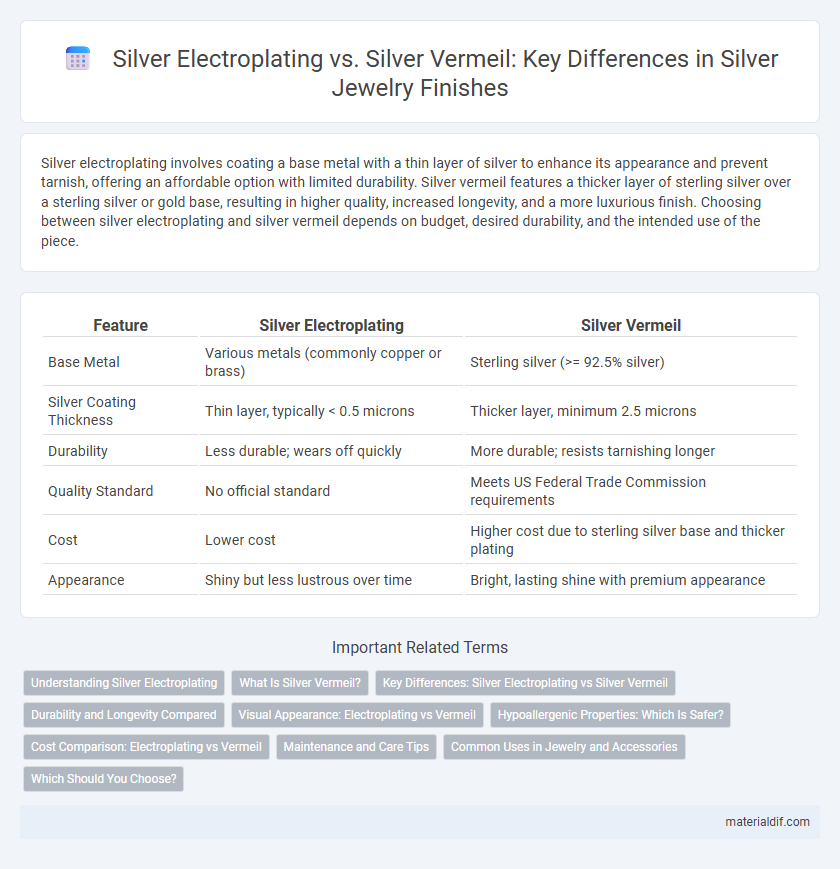Silver electroplating involves coating a base metal with a thin layer of silver to enhance its appearance and prevent tarnish, offering an affordable option with limited durability. Silver vermeil features a thicker layer of sterling silver over a sterling silver or gold base, resulting in higher quality, increased longevity, and a more luxurious finish. Choosing between silver electroplating and silver vermeil depends on budget, desired durability, and the intended use of the piece.
Table of Comparison
| Feature | Silver Electroplating | Silver Vermeil |
|---|---|---|
| Base Metal | Various metals (commonly copper or brass) | Sterling silver (>= 92.5% silver) |
| Silver Coating Thickness | Thin layer, typically < 0.5 microns | Thicker layer, minimum 2.5 microns |
| Durability | Less durable; wears off quickly | More durable; resists tarnishing longer |
| Quality Standard | No official standard | Meets US Federal Trade Commission requirements |
| Cost | Lower cost | Higher cost due to sterling silver base and thicker plating |
| Appearance | Shiny but less lustrous over time | Bright, lasting shine with premium appearance |
Understanding Silver Electroplating
Silver electroplating involves coating a base metal with a thin layer of pure silver using an electrochemical process, enhancing its appearance and corrosion resistance. This method uses an electric current to reduce dissolved silver ions onto the metal surface, ensuring a smooth and uniform finish. Compared to silver vermeil, which requires a thicker layer of silver over sterling silver, electroplating typically results in a thinner silver coating suited for decorative purposes.
What Is Silver Vermeil?
Silver vermeil is a high-quality jewelry material consisting of a thick layer of pure sterling silver plated over a base of solid gold, typically 10k or 14k gold. Unlike standard silver electroplating, which applies a thin silver layer over less precious metals and wears off quickly, silver vermeil offers enhanced durability and resistance to tarnishing. This combination of precious metals provides an affordable yet luxurious alternative to solid gold or pure silver pieces.
Key Differences: Silver Electroplating vs Silver Vermeil
Silver electroplating involves applying a thin layer of pure silver onto a base metal, often resulting in a shorter lifespan and higher susceptibility to tarnishing. Silver vermeil features a thicker layer of sterling silver over a solid sterling silver or gold core, offering enhanced durability and a more valuable composition. The key differences lie in the silver thickness, base metal quality, and overall longevity of the finished piece.
Durability and Longevity Compared
Silver electroplating involves applying a thin layer of silver over a base metal, resulting in a less durable finish that may wear off within months with frequent use. Silver vermeil features a thicker layer of sterling silver over a solid sterling silver base, providing significantly greater durability and longevity that can last for years with proper care. The thicker silver layer in vermeil resists tarnishing and wear better than standard electroplated pieces, making it a superior choice for long-lasting silver jewelry.
Visual Appearance: Electroplating vs Vermeil
Silver electroplating produces a thin layer of silver on various base metals, resulting in a shiny but often less lustrous finish compared to silver vermeil. Silver vermeil features a thicker layer of sterling silver over a solid gold base, providing a brighter, more durable, and richer visual appearance. The enhanced thickness in vermeil plating ensures a longer-lasting, high-quality shine that resists tarnishing better than standard electroplating.
Hypoallergenic Properties: Which Is Safer?
Silver electroplating uses a thin layer of silver over a base metal, which may cause allergic reactions if the base metal contains nickel or other allergens. Silver vermeil consists of a thicker 2.5-micron layer of sterling silver over a sterling silver or gold base, enhancing its hypoallergenic properties and reducing the risk of skin irritation. Choosing silver vermeil typically offers a safer option for people with sensitive skin due to its higher purity and thicker silver coating.
Cost Comparison: Electroplating vs Vermeil
Silver electroplating typically costs less due to a thinner layer of silver applied over a base metal, making it more affordable but less durable. Silver vermeil involves a thicker sterling silver coating over sterling silver or gold, resulting in higher costs but greater quality and longevity. The price difference reflects the silver purity, coating thickness, and craftsmanship required for vermeil compared to standard electroplated pieces.
Maintenance and Care Tips
Silver electroplating requires careful maintenance to prevent tarnish, including regular cleaning with a soft cloth and storing pieces in anti-tarnish bags to minimize exposure to air and moisture. Silver vermeil, consisting of a thick layer of sterling silver over a base metal, demands gentle cleaning with mild soap and water to protect the delicate silver layer from wearing off. Avoid abrasive materials and chemicals on both types to extend the lifespan and maintain the bright, lustrous finish of silver jewelry.
Common Uses in Jewelry and Accessories
Silver electroplating is widely used in affordable jewelry and accessories to create a thin layer of silver over base metals, offering a lustrous finish suitable for costume pieces and fashion items. Silver vermeil involves a thicker layer of sterling silver over a base of gold or sterling silver, making it ideal for higher-end jewelry with enhanced durability and hypoallergenic properties. Both methods enhance aesthetics and corrosion resistance, but silver vermeil is preferred for fine jewelry due to its superior quality and longevity.
Which Should You Choose?
Silver electroplating involves coating a base metal with a thin layer of pure silver, offering an affordable option that provides a shiny finish but may wear off over time. Silver vermeil consists of a thicker layer of sterling silver plated over sterling silver or a base metal, ensuring greater durability and a higher quality appearance ideal for fine jewelry. Choose silver electroplating for budget-friendly pieces with occasional use, while silver vermeil suits items meant for long-lasting wear and a more luxurious look.
Silver Electroplating vs Silver Vermeil Infographic

 materialdif.com
materialdif.com